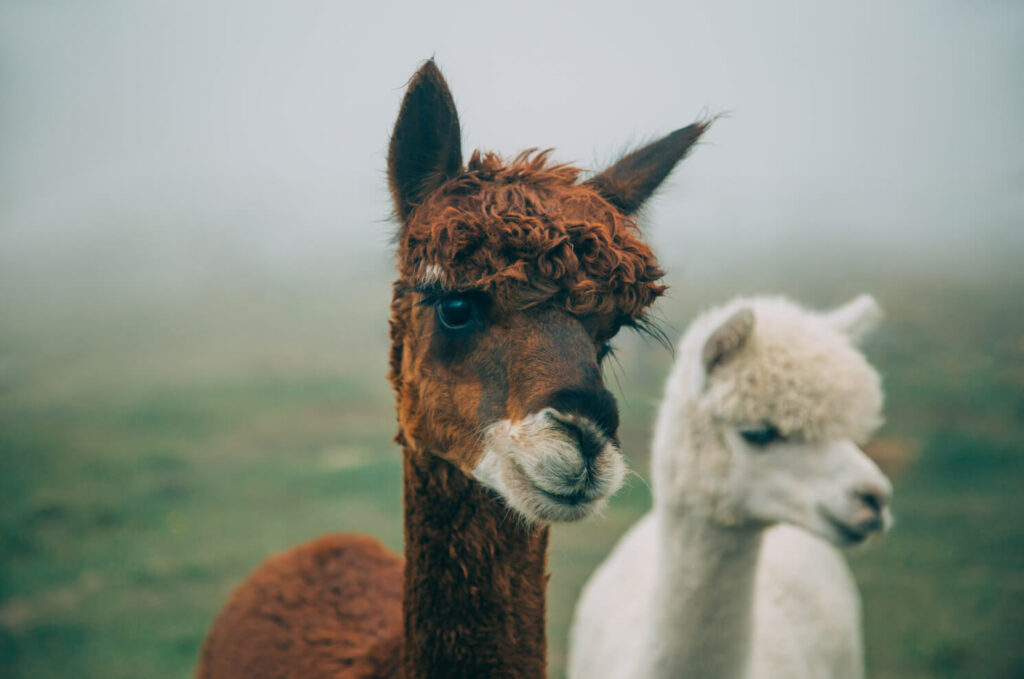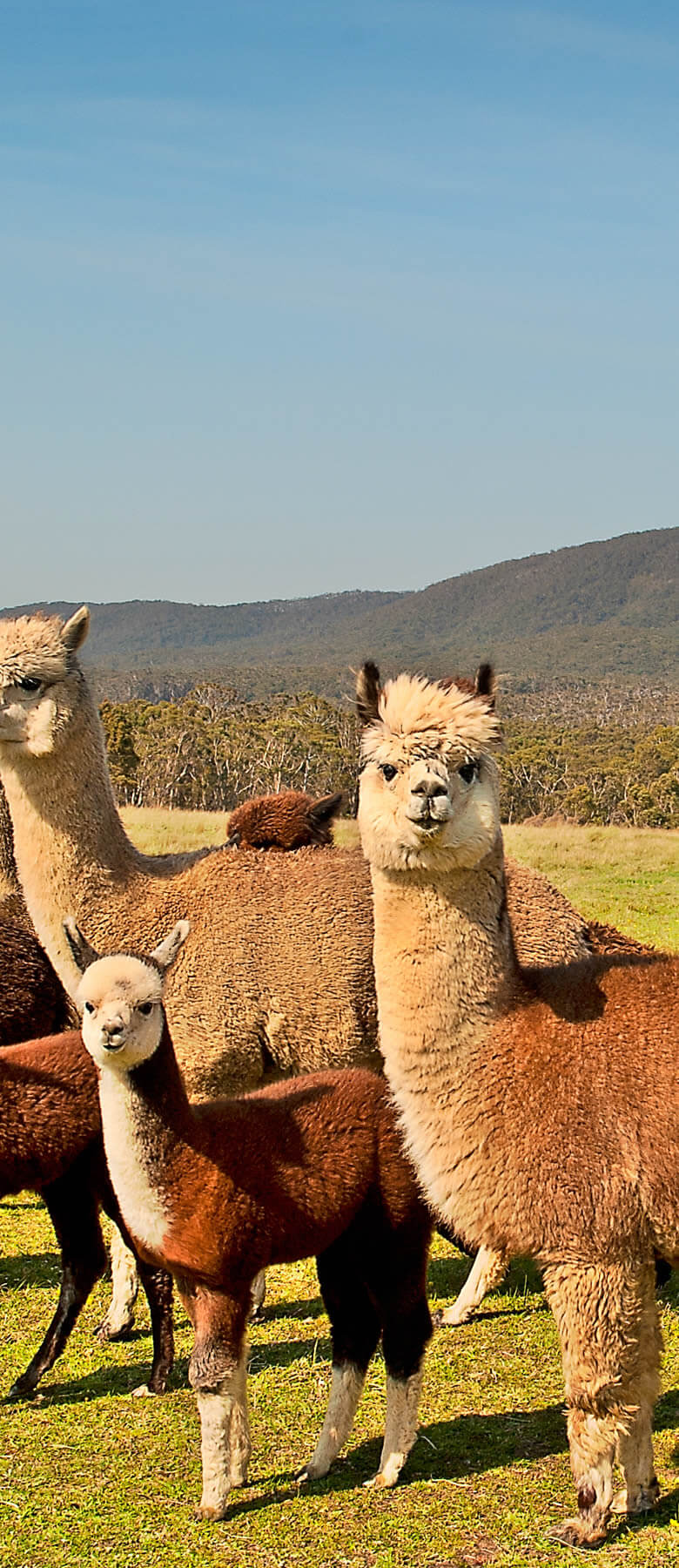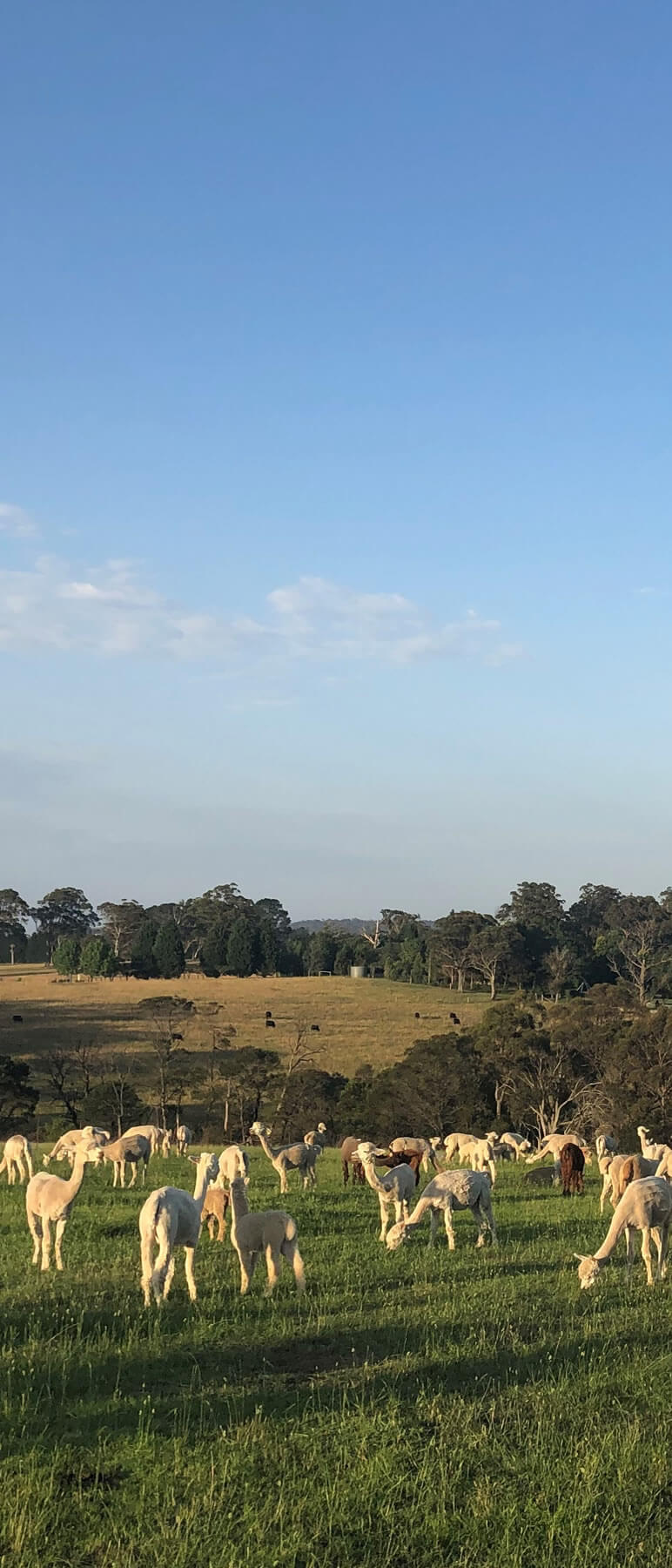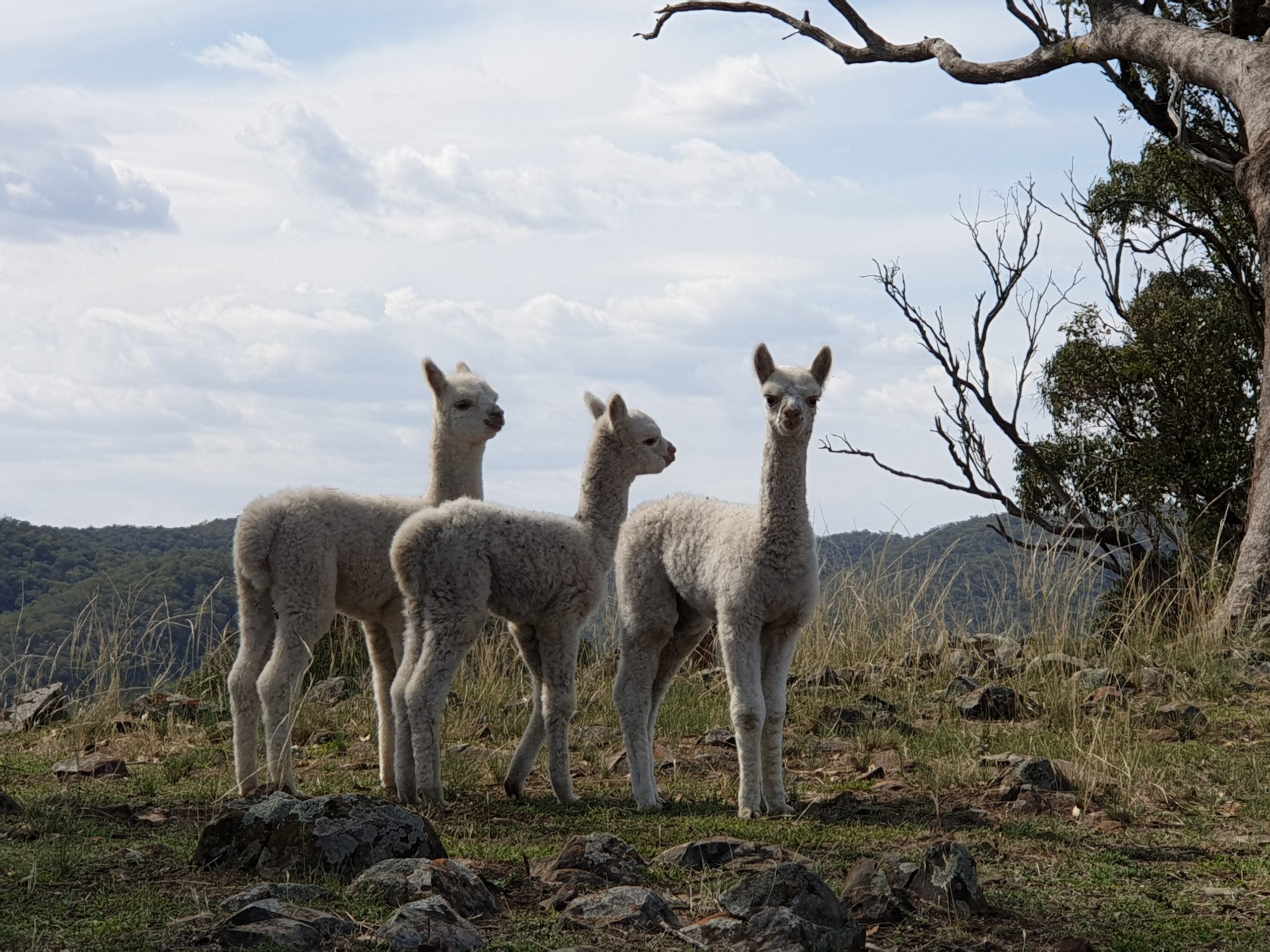Alpaca care
You have an ethical and legal responsibility to provide optimal welfare and sound husbandry practices to all livestock on your farm.
Are you buying your first alpacas?
Alpacas need to be handled calmly and with care to prevent distress and injury to the animals and the handlers. When working with alpacas, consistent quiet and slow behaviour makes them very easy to handle and they will usually herd easily. Alpacas learn quickly and will usually learn to come up to a feeding pen when called. Alpaca are curious animals with an exceptionally strong herd instinct. An alpaca should never be kept on its own or as a domesticated pet. Some alpaca have bonded with other species; however two or more alpaca kept together is preferable for their well being.
Alpacas will hum as a method of communication with other herd members. Dams may cluck at their young. When an alpaca sees what they consider a source of danger, they may emit a high pitched squeal to alert other herd members. Alpaca’s protective nature towards their herd makes them very efficient at protecting their young and other species with whom they have bonded, such as lambs and kids. Alpacas are no match for two or more dogs and losses have been sustained to dog attack, most often domestic dogs.
The herd will have a community dung pile and, if necessary, will even line up and wait for their turn.
Normal 7 or 8-wire sheep fences are sufficient to keep alpacas in their paddock. They do not challenge fences although if the wire strands are too loose, the young may try to climb through. Electric fencing should not be used to contain alpacas.
Transporting alpacas?
Basic Husbandry Requirements
All husbandry procedures and treatments should be documented in appropriate farm records.
Teeth
Alpaca usually have six incisor teeth at the front of the lower jaw but no front teeth at the front of the upper jaw. Lower incisor teeth that are correctly aligned with the upper dental pad will naturally wear down as the animal grazes. Some alpaca (usually older) can occasionally have teeth that overshoot the dental pad and thereby continue to grow. Normal practice is to trim these teeth as required. If the teeth are not trimmed, these animals may have difficulty grazing sufficient quantities of feed on short summer pastures to maintain their body condition. By around 4 years old all alpacas develop canine teeth on both upper and lower jaws behind the incisors. Males develop fighting teeth at about two years of age (around sexual maturity) and these should be trimmed to avoid injuries being inflicted on other males. Teeth trimming should only be carried out by a trained and competent person.
Toenails
Alpacas have soft padded feet with two toenails on each foot and a soft leathery pad. Alpaca’s toenails require trimming two to three times a year. However, nails will grow at different rates on different animals so should be monitored on a regular basis. Nails left unattended can twist and deform the foot and cause lameness. Neglected toenails may also cause infection under the nail.
Shearing
Alpaca are born with a naturally clean breech and do not require mulesing or crutching. Generally, pregnant females should not be shorn within the first 8 weeks and the last 8 weeks of their pregnancy. However if done with care, shearing heavily pregnant females is preferable to the possibility of her being in full fleece through summer due to the high potential of hyperthermia. Alpacas do not shed their fleece and an unshorn animal can be prone to matting at the skin with the potential of creating skin conditions and further inhibiting air movement to aid in the cooling of the animal making them predisposed to hyperthermia. Over-fleeced animals are also at risk of hypothermia. With hypothermia, rain can weigh a heavy fleece down creating a part down the spine, thus allowing water to enter the fleece and chill the skin.
Worms / Drenching
Alpaca are susceptible to both cattle and sheep internal parasites, however alpaca’s natural latrine practices and good nutrition can assist in ensuring these parasites are rarely in disease causing proportions. Some alpacas are drenched for protection against internal parasites once or twice per year depending on the health regime determined between the owner and their Veterinarian. Some alpacas are never drenched for internal parasites as their owners monitor faecal egg counts and practice pasture rotation.
The most challenging internal parasites for alpaca are:
- Barber’s Pole Worm – Haemonchus contortus
- Small Brown Stomach Worm – Ostertagia ostertagi
- Black Scour Worm – Trichostrongylus spp
- Liver fluke – Fasciola hepatica
The alpaca industry is starting to experience some drench resistance; regular faecal egg counts and improved management practices are recommended over frequent use of anthelmintics. There are no drenches on the market today that are registered for use in alpaca however their use under the direction of a veterinarian is permissible.

Nutrition
Alpacas may be run on small or large acreages. A key to their nutrition is to match stocking rates with pasture production to avoid over-grazing, weed spread and soil erosion. Body condition of alpacas is assessed on a scale of 1 (very thin) to 5 (very fat). It can be useful to check on body condition regularly to make sure no alpaca is losing condition and to signal the need to take action if any of them is losing weight. The alpaca’s generous fleece can effectively mask its body condition, so ‘hands-on’ assessment is important.
Water
Most alpaca are attracted to water and will actively seek to keep cool on hot days by standing in their water troughs, irrespective of whether they have been shorn or not; this in turn will foul their drinking water. A clean water supply is essential for sustaining a healthy alpaca. Consumption rates are generally in the range of 5 – 8 % of body weight per day.
Feed
Alpacas are primarily grazers and eat small amounts of a wide variety of plants. Alpacas should ideally be pasture fed at all times. They rely on foregut fermentation and chew the cud, like sheep and cattle, to extract nutrients from feed. They prefer shorter pastures but will graze longer grass if this is all that is available. The quantity eaten will vary considerably and is dependent on the digestibility of the pasture (actively growing, green grass/legumes before flowering are the most digestible) and also on the animal’s physiological status – lactating females will have a much higher nutritional requirement. Alpacas will do well on high quality native pastures or most introduced species.
When the quality or quantity of pasture is limited, alpacas may be supplemented with good quality lucerne or clover hay and/or high energy or protein feeds such as cracked lupins according to their physiological state (eg, pregnancy, lactation, growth, maintenance). Alpacas can also be supplemented using a commercial mix or pellets designed for alpacas. Oaten, paddock or grassy hay will provide less in terms of protein and energy, but are a good source of fibre. Roughage/fibre in the form of hay may be required especially if pasture is very short or has a high water content.
Care should be taken to avoid consumption of poisonous plants such as oleander, azalea and lantana.
Vitamin / Mineral Supplementation
Water-soluble vitamins(e.g.B and C) are provided by the microbes that live in the fore-stomachs, so healthy alpacas do not require supplementation. Fat-soluble vitamins (A and E) are available from green vegetation so only need supplementation if pasture is completely dry for more than 8-10 weeks. Vitamin D supplementation is required in alpacas. Cria and young alpaca are susceptible to Rickets and White Muscle Disease (selenium deficiency) with breeders routinely supplementing their animals according to the requirements of their particular region. ADE vitamins help prevent rickets, limb deformities and joint pain especially in growing animals.
Vaccinations
Vaccinations protect alpacas from preventable clostridial diseases such as pulpy kidney and tetanus. Alpacas should be vaccinated at least twice yearly (coming into spring and autumn) with 5 in 1 vaccine.
Reproduction
Intact males or recently castrated males must not be run with females as they can harass the females which can cause stress and sometimes cause pregnant females to abort. Entire male alpacas should not be run with sheep or goats
Castration
Castration is an important component of the on-farm management of male alpacas in Australia, because it decreases aggression towards other alpacas and humans, and improves the economic value of the herd, since wethers can be sold as guard animals, for fleece production, or used in the evolving alpaca meat industry. Surgical castration is an Act of Veterinary Science in some Australian jurisdictions. The use of pain relief is recommended. Alpaca scrotal anatomy is not suitable for the use of rubber rings as a form of castration – rubber rings should NOT be used.
Pregnancy
The length of pregnancy is usually between 335 and 355 days but it can be as long as 390 days. Generally the pregnancy length of any one female is similar from one pregnancy to the next so it’s a good idea to keep breeding records for individuals.
Pregnancy testing
Seven days after mating, it is possible to test for pregnancy using a “spit-off” test. If the female sees her suitor off by spitting, she is probably pregnant.

Other advice
Hyperthermia or Heat Stress
Hyperthermia occurs when the core body temperature is elevated above the normal range of 37.5ºC – 38.6ºC. Cria can be up to 1ºC deg higher. Daytime body temperature for adults may also raise 1ºC. The potential for heat stress to occur is when the body temperature reaches 40 ºC – 41 ºC and is further exacerbated with high humidity. Alpacas transfer heat and cold through their ventral area (bellies) and the following signs may be indicative of heat stress:
- Animals can be lethargic and appear depressed.
- May be seen panting with their mouths open and nostrils flared.
- May be recumbent and refuse to stand.
- The central nervous system can be affected; causing depressed mental function and possible convulsions.
In pregnant females heat stress can cause reproductive failure, abortions and foetal damage. Heavily pregnant females are highly susceptible to heat stress. In entire males temporary or permanent infertility is possible. Newborn cria are highly susceptible to heat stress. Losses of newborn and very young cria through dehydration have been recorded.
NOTE: Alpacas carrying excessive fleece are highly prone to heat stress
Hypothermia or Cold Stress
Hypothermia is a reduction in the body’s core temperature usually caused by low ambient temperatures, wind, and rain. Hypothermia can occur irrespective of the climatic zone. Risk for hypothermia must always be suspected when there is an (unseasonal) drop in the temperature combined with and rain and a resulting windchill factor.
- Animals will be down, unable to ‘cush’ (sitting position with legs tucked under the body), slow respiration and in severe cases may be moribund.
- The normal temperature for an alpaca is around 37.5ºC – 38.6ºC degrees. A core temperature of 34 degrees or lower is a critical sign.
- Huacaya in the first 3 weeks off shears are particularly vulnerable to hypothermia. Suri alpacas, due to the structure of their fleece are vulnerable to hypothermia in severe cold/wet weather events regardless of the length of fleece
Defence mechanisms
Alpaca in their evolving environment are prey animals. Their natural instinct is to escape capture and disguise illness so as not to attract the attention of predators. This instinct can make detecting illness difficult. An alpaca’s preference is to avert danger or capture; however they are not without defense mechanisms. Some alpaca can kick out occasionally in confined areas, although their soft padded foot presents no danger to the recipient compared to the kick of a horse.
Alpaca spit is the contents of the rumen. Spitting is the means for an alpaca to establish its place in the pecking order of the herd. Spitting at humans is not as common as assumed but can occur when an animal is protecting its young or feels threatened in a confined space. An alpaca will generally not spit on its own cria. When handling cria, placing or holding the cria between the dam and the handler may prevent being spat on.
Aberrant Behaviour Syndrome (ABS)
Like all livestock species, an alpaca that is over petted or over handled can be predisposed to develop excessively familiar behaviour towards humans. In essence, the alpaca will consider humans as one of its kind. This situation is not common in alpaca but should it occur it is most often due to cria that have been raised as a poddy by inexperienced persons, or those that are kept as pets and fussed over excessively. The condition Aberrant Behaviour Syndrome (ABS) is also referred to as Berserk Male Syndrome, however the condition does not always apply to just males. Animals with ABS will display extreme aggressive behaviour towards humans and other alpaca alike. Aggressive behaviour includes rushing at the fence and rearing up, running towards a person in a weaving motion with head lowered towards the ground, chest butting, broad side posturing with head tilting upwards and biting. Extreme care must be taken when entering a paddock or handling these kinds of animals. There is no rehabilitation or retraining for an animal with true ABS
Halter Training
Halter trained alpacas can be an asset when needing to relocate them within walking distances, particularly if there is no lane-way system on the property. It is a requirement that all alpacas entered in AAA shows be halter trained for judging. Methods of training are numerous, but firm and gentle persistence is common to all. Halter training is generally begun after weaning but alpacas can begin to be haltered from a few weeks old. Many alpacas have also been successfully trained as adults, and most only require a small number of lessons.
The most important feature of a halter is that it fits firmly and comfortably. An ill-fitting halter will slip down the muzzle and restrict the alpaca’s breathing. This causes a snorting sound and the restricted airflow often panics the alpaca. An obvious indication that the halter is not correctly fitted around the muzzle is flaring of the nostrils. Selecting a halter with an adjustable nose band will greatly assist in ensuring a good fit. Never leave a halter on an unattended alpaca in the paddock and always detach the lead rope from the halter if you are not actually with a haltered alpaca.
Most alpaca breeders are familiar with halter training techniques and guidance is best sought from someone with experience. AAA workshops sometimes have practical sessions covering halter training and alpaca handling – keep an eye out in our events calendar.
Alpaca Advice
AAA Members have access to comprehensive alpaca advice sheets.
For more information about membership
We highly recommend the AAA publication “Managing Alpacas in Australia” – an introductory guide for new alpaca owners in Australian conditions.


